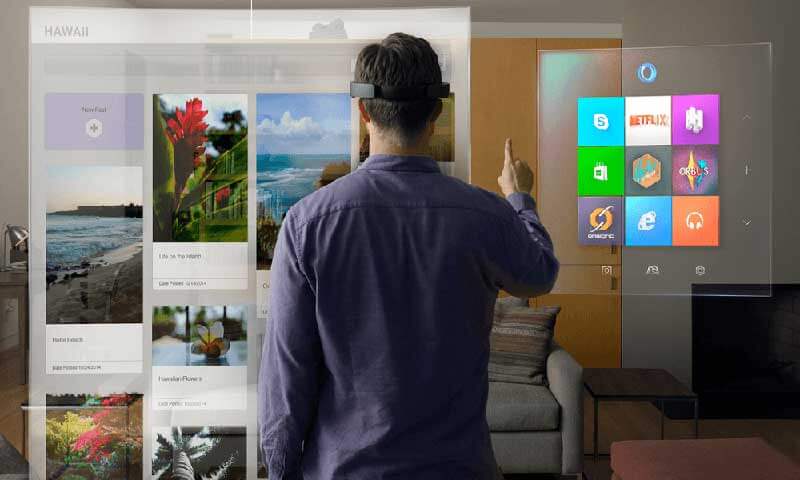- Mixed reality combines the best of VR and AR
- High prices and complex hardware have been holding back the future
- Seamless integration is a lot harder than it sounds
- ThyssenKrupp AG leads the way
Virtual and augmented reality first made a public splash with the incredible popularity of Pokémon Go! This augmented reality game had hundreds of millions of people hunting pocket-monsters in the real world, and exposed the public to the fun side of this new tech. But let’s not downplay just how important these new technologies can be.
Virtual reality (VR) creates an immersive experience of a digital world. By contrast, augmented reality (AR) overlays the real with digital content. Neither need be just fun and games. For instance, VR offers fantastic opportunities for architecture and construction, offering designers, foremen, and clients powerful tools for visualisation. And AR may be even more useful. Consider how a high-tech factory could leverage the power of this tech to provide skilled labour with data overlays or graphic schematics they can access in a virtual space next to a project. Now, just imagine how this tech can help surgeons visualise organ placements and prepare for surgery!
Free trendservice
Mixed reality combines the best of VR and AR
But perhaps the most promising development has been the exploration of a ‘sweet spot’ between these two concepts – mixed reality (MR), which combines the best of both worlds. Industry insiders like Alex Kipman think that tech that finds the right combination of immersion and augmentation is set to transform the world. We agree – and we suggest this is because MR has the best features of both approaches and because it looks to solve some of the nagging problems bedeviling these technologies. These problems come in two general varieties: trouble with the tech and trouble with the hardware.

High prices and complex hardware have been holding back the future
Until very recently, VR, AR, and MR depended on one of two hardware options. Either users accepted the inherent limitations to immersion imposed by wired headsets, or they were forced to throw down a cool $3,000 for Microsoft’s HoloLens. Microsoft’s engineers realised early on that wired headsets limited users’ immersion and broke the spell that VR casts at its best. But that price point isn’t realistic for most consumers, reducing the reach of the tech. Microsoft’s solution is to bring wireless VR headsets into the price range of wired competitors like Oculus Rift, somewhere in the $300 to $500 range, according to Fast Company’s Alice Bonasio.
Another hardware problem Microsoft’s engineers have been working on is plug-and-play simplicity. In the past, setup was complicated enough that users frequently returned the tech when they were unable to make it work. And to get a high-end headset to function properly, the latest processors and graphics cards were needed, adding to the cost and implicit elitism of the tech. But with this months’ Creator’s Update for Windows 10, MR headsets should be able to function with a pretty standard PC. As Greg Sullivan, the director of communications for Windows and Devices at Microsoft, explained to Design News, “You’ll be able to connect them to a mainstream PC that costs closer to $500.” That’s an exciting move by Microsoft, bringing some pretty cutting-edge tech into the reach of the average consumer and providing the access that generates widespread adoption.
Seamless integration is a lot harder than it sounds
But the technical hurdles to make MR work are incredible. Part of what sets it apart from VR and AR is that it melts the virtual into the real, modelling the user’s environment. For MR to place virtual objects onto real surfaces, and for those objects to look and behave as though they’re affected by the laws of physics and common sense, is a lot harder than it sounds. Professor Gregory Welch, a computer scientist at the University of Central Florida, notes that this seamless integration is tough. “MR is particularly difficult in that respect because there is no hiding the imperfections of the virtual, nor the awesomeness of the real.” When you juxtapose a scenic view to a 3D rendering, that digital object better be stunningly flawless. Unfortunately, we’re just not there yet.
Welch’s research suggests that the narrow fields of view offered by the current tech break immersion. If, for instance, “you are looking at a virtual human in front of you (as we did in our experiment), you will only see a portion of them floating in space in front of you. You have to move your head up and down to ‘paint’ a perception of them, as you cannot see the entire person at once, unless you look at them from far away (so they appear smaller). The problem appears to be that your brain is constantly seeing the ‘normal’ world all around, and that apparently ‘overrides’ many perceptions or behaviours you might otherwise have”. MR wants to combine the immersion of VR with the utility of AR – and until it works this problem out, it won’t see the kind of adoption we might anticipate.

ThyssenKrupp AG leads the way
But that hasn’t stopped a number of forward-thinking companies from adopting this innovative approach. For example, ThyssenKrupp AG, the German elevator giant, already uses Microsoft’s HoloLens to help its repair technicians. When a service professional arrives at an elevator in need of repair, he is met with a floating graphic explaining the elevator’s service history. Check out this amazing video of how it works:
As ThyssenKrupp’s success demonstrates, MR isn’t just hype. When engineers get the kinks worked out, expect MR to explode into your life and workplace.
Share via:


